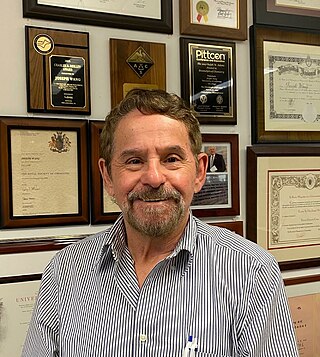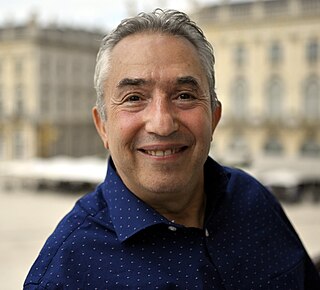
Norman Hackerman was an American chemist, professor, and academic administrator who served as the 18th President of the University of Texas at Austin (1967–1970) and later as the 4th President of Rice University (1970–1985). He was an internationally known expert in metal corrosion.

John Bannister Goodenough was an American materials scientist, a solid-state physicist, and a Nobel laureate in chemistry. From 1986 he was a professor of Materials Science, Electrical Engineering and Mechanical Engineering, at the University of Texas at Austin. He is credited with identifying the Goodenough–Kanamori rules of the sign of the magnetic superexchange in materials, with developing materials for computer random-access memory and with inventing cathode materials for lithium-ion batteries.
Bernhardt Patrick John O’Mara Bockris was a South African professor of chemistry, latterly at Texas A&M University. During his long and prolific career he published some 700 papers and two dozen books. His best known work is in electrochemistry but his output also extended to environmental chemistry, photoelectrochemistry and bioelectrochemistry. In the 1990s he experimented with cold fusion and transmutation, topics on which his unorthodox views provoked controversy.

Sir Michael Stanley Whittingham is a British-American chemist. He is a professor of chemistry and director of both the Institute for Materials Research and the Materials Science and Engineering program at Binghamton University, State University of New York. He also serves as director of the Northeastern Center for Chemical Energy Storage (NECCES) of the U.S. Department of Energy at Binghamton. He was awarded the Nobel Prize in Chemistry in 2019 alongside Akira Yoshino and John B. Goodenough.

Joseph Wang is an American biomedical engineer and inventor. He is a Distinguished Professor, SAIC Endowed Chair, and former Chair of the Department of Nanoengineering at the University of California, San Diego, who specialized in nanomachines, biosensors, nano-bioelectronics, wearable devices, and electrochemistry. He is also the Director of the UCSD Center of Wearable Sensors and co-director of the UCSD Center of Mobile Health Systems and Applications (CMSA).

Allen Joseph Bard was an American chemist. He was the Hackerman-Welch Regents Chair Professor and director of the Center for Electrochemistry at the University of Texas at Austin. Bard developed innovations such as the scanning electrochemical microscope, his co-discovery of electrochemiluminescence, his key contributions to photoelectrochemistry of semiconductor electrodes, and co-authoring a seminal textbook.
Electrochemical engineering is the branch of chemical engineering dealing with the technological applications of electrochemical phenomena, such as electrosynthesis of chemicals, electrowinning and refining of metals, flow batteries and fuel cells, surface modification by electrodeposition, electrochemical separations and corrosion.

Electrochemical and Solid-State Letters (ESL) was a peer-reviewed scientific journal that began publication in 1998 as a joint publication of the Electrochemical Society and the IEEE Electron Devices Society. The final issue was published in 2012. The journal is now preserved as an archive, and has been replaced by ECS Electrochemistry Letters and ECS Solid State Letters.
Interface is a quarterly open access scientific journal published by the Electrochemical Society covering developments in electrochemistry and solid-state chemistry, as well as news and information about and for members of the society.

'Jose H. Zagal Moya is a Chilean scientist educated at the University of Chile with postgraduate training in the United States of America with a Ph.D. degree from Case Western Reserve University, Cleveland Ohio and postdoctoral training at Brookhaven National Laboratory, Upton, New York. At present he is a Distinguished Professor, Department of Chemistry and Materials, Faculty of Chemistry and Biology, Universidad de Santiago de Chile (USACH) where he directs the Laboratory of Electrocatalysis since 1982. He got his Ph.D. in chemistry Case Western Reserve University, US (1978) and was postdoctoral fellow at Brookhaven National Laboratory, Upton, New York, in 1982. His main research efforts are focused on the fundamentals of electron transfer reactions that are relevant for energy conversion and sensors. He has contributed in the area of electrocatalysis, electrodes modified with metal macrocyclics, electrochemistry of biological molecules, the catalysis of the reduction of molecular oxygen and many other reactions of relevance, conductive polymers, electrochemical sensors and in pioneering work in the establishment of non-linear correlations between thermodynamic properties of molecular catalysts and their electrochemical reactivity. These contributions are essential in the development of non-precious metal catalysts for energy conversion devices and electrochemical sensors. [1][2][3] He also has contributed in the field of corrosion, conductive polymers and his well-known volcano correlations for the electrocatalytic properties of surface-confined molecular catalysts
John Scott Newman is an American retired academic. A professor and renowned battery and electrochemical engineer researcher, he worked at the University of California in the Department of Chemical Engineering. The Newman Research Group was established with the goal of identifying "efficient and economical methods for electrochemical energy conversion and storage, development of mathematical models to predict the behavior of electrochemical systems and to identify important process parameters, and experimental verification of the completeness and accuracy of the models". Newman also worked for the Electrochemical Technologies Group at Lawrence Berkeley National Laboratory where he was a Faculty Senior Scientist. While at LBNL he served as director of several Department of Energy’s energy storage programs, including the Batteries for Advanced Transportation Technologies Program. He was elected a member of the National Academy of Engineering in 1999 for contributions to applied electrochemistry and for their reduction to practice through advances in electrochemical engineering. He was an Onsager Professor at the Norwegian University of Science and Technology in 2002. Newman is regarded by many as "the father of electrochemical engineering." The Newman Method is a "numerical technique...developed for solving coupled electrochemical reaction–diffusion equations".

The Edward Goodrich Acheson Award was established by The Electrochemical Society (ECS) in 1928 to honor the memory of Edward Goodrich Acheson, a charter member of ECS. The award is presented every 2 years for "conspicuous contribution to the advancement of the objectives, purposes, and activities of the society (ECS)".
The Norman Hackerman Young Author Award was established in 1982 by The Electrochemical Society (ECS). The award is presented annually for the best paper published in the Journal of the Electrochemical Society for a topic in the field of electrochemical science and technology by a young author or authors.
Martin Winter is a German chemist and materials scientist. His research in the field of electrochemical energy storage and conversion focuses on the development of new materials, components and cell designs for batteries and supercapacitors, lithium ion batteries and lithium metal batteries.

Doron Aurbach is an Israeli electrochemist, materials and surface scientist.
Viola Ingrid Birss is a Professor of Chemistry at the University of Calgary and has been the holder of a Tier 1 Canada Research Chair in Fuel Cells and Related Clean Energy Systems for two 7-year terms. She works on electrochemical and nanomaterial technologies to advance clean energy and environmental applications. She is a prolific scientist with over 350 refereed scientific publications. She has also supervised over 200 undergraduate, graduate and post-doctoral students and is an avid advocate for EDI, specifically in the attraction and retention of women in science and engineering.
Héctor Daniel Abruña is a Puerto Rican physical chemist whose work focuses on electrochemistry, molecular electronics, fuel cells, batteries, and electrocatalysis. Abruña is director of the Energy Materials Center and Emile M. Chamot professor for chemistry at Cornell University. He became a Fellow of the American Association for the Advancement of Science in 2006, a Member of the American Academy of Arts and Sciences in 2007, and a Member of the National Academy of Sciences in 2018. Abruña conducts research into battery and fuel cell systems using electrochemical techniques and X-ray microscopy and spectroscopy methods.
Peter Strasser is a German chemist. He is the winner of the 2021 Faraday Medal.
Betar Maurkah Gallant is an American engineer who is an associate professor at Massachusetts Institute of Technology. Her research investigates the development of new materials for batteries.

Karim Zaghib is an Algerian-Canadian electrochemist and materials scientist known for his contributions to the field of energy storage and conversion. He is currently Professor of Chemical and Materials Engineering at Concordia University. As former director of research at Hydro-Québec, he helped to make it the world’s first company to use lithium iron phosphate in cathodes, and to develop natural graphite and nanotitanate anodes.









